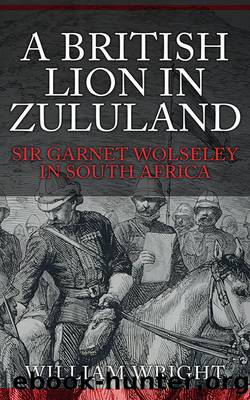A British Lion in Zululand: Sir Garnet Wolseley in South Africa by William Wright

Author:William Wright
Language: eng
Format: epub
Publisher: Amberley Publishing
Published: 2017-01-15T16:00:00+00:00
PART TWO
THE BAPEDI
6
TROUBLE IN THE TRANSVAAL
I say the land belongs to us â¦
Chief Johannes Dinkwanyane
âThe Zulu War is ended,â wrote a jubilant Wolseley to the Duke of Cambridge on 2 September 1879. The day was going to turn into a hot one as the spring sun rose quickly in the sky, and after breakfast Sir Garnet held a review of his troops before breaking up the units. Mansfield Clarkeâs column commenced its journey back to Natal, the 80th Regiment was sent north towards Utrecht and the general and his staff prepared to make their way to Pretoria, capital of the Transvaal, via Evelyn Woodâs old camp on the Blood River. That night a âhighly pleasedâ John Dunn dined one last time with his mentor before turning homeward.
On the next morning Wolseley attended to his despatches, planning to set off on the 4th, but the heat in the tents was âvery unpleasantâ, while the flies in their thousands were âmaddeningâ, drawn by the carcasses of many unburied bullocks and general camp detritus. Fed up with the sickening smells and keen to get going, Sir Garnet gave the order to start the march that night at 10 p.m. under âa very good bright moonâ.
In fact, Zulu campaigning was not quite over; Manyonyoba, an inkosi of the Khubeka people in the Ntombe Valley, had still not surrendered, though he sent word that at sunset on 4 September he was prepared to lay down his weapons. The Zulu War, which might have ended without further loss of life, was now destined for a last blood-letting; on the morning of the 4th Baker Russell received orders from Wolseley to âclear Manyonyoba outâ. Sceptical of his opponentâs intentions, Russell duly ordered Major Wilsone Black, a peppery Glaswegian from 2/24th, to take a force consisting of Tetelukuâs Mounted Natives and some mounted infantry and march on the chiefâs stronghold near the banks of the Ntombe. Force was to be used only as a last resort and seven Zulus found hiding in a cave were allowed to surrender with the promise that their lives would be spared. Climbing up a steep hillside where other Zulu men, women and children, along with their livestock, were all sheltering in other caves, Blackâs force was fired upon by one of Manyonyobaâs people. This lone shot by a nervous warrior was enough for Tetelukuâs men, whose white officers were absent, to assegai the unarmed prisoners and butcher them all. Manyonyobaâs Zulus, naturally enough, got wind of this killing and refused to leave the caves shouting out that they no longer believed the words of the white men. Tetelukuâs warriors, much to Blackâs fury, were completely unrepentant and marched to their bivouac singing victory songs.
Next day, 5 September, Russell sent a large patrol to take Manyonyobaâs main cave on the left bank of the Ntombe. The events were described by Captain W. E. Montague:
It was a stiff climb, pretty enough to watch â the red coats dodging in and out, half hidden by
Download
This site does not store any files on its server. We only index and link to content provided by other sites. Please contact the content providers to delete copyright contents if any and email us, we'll remove relevant links or contents immediately.
| Africa | Americas |
| Arctic & Antarctica | Asia |
| Australia & Oceania | Europe |
| Middle East | Russia |
| United States | World |
| Ancient Civilizations | Military |
| Historical Study & Educational Resources |
Magic and Divination in Early Islam by Emilie Savage-Smith;(1197)
Ambition and Desire: The Dangerous Life of Josephine Bonaparte by Kate Williams(1088)
Operation Vengeance: The Astonishing Aerial Ambush That Changed World War II by Dan Hampton(987)
What Really Happened: The Death of Hitler by Robert J. Hutchinson(874)
London in the Twentieth Century by Jerry White(849)
Time of the Magicians by Wolfram Eilenberger(845)
Twilight of the Gods by Ian W. Toll(815)
The Japanese by Christopher Harding(804)
Papillon by Henry Charrière(796)
Lenin: A Biography by Robert Service(781)
The Devil You Know by Charles M. Blow(781)
Twelve Caesars by Mary Beard(770)
Freemasons for Dummies by Hodapp Christopher;(750)
The Churchill Complex by Ian Buruma(732)
Napolean Hill Collection by Napoleon Hill(706)
The Enlightenment by Ritchie Robertson(693)
Henry III by David Carpenter;(690)
Bohemians, Bootleggers, Flappers, and Swells: The Best of Early Vanity Fair by Bohemians Bootleggers Flappers & Swells- The Best of Early Vanity Fair (epub)(689)
The Rise and Triumph of the Modern Self by Unknown(660)
